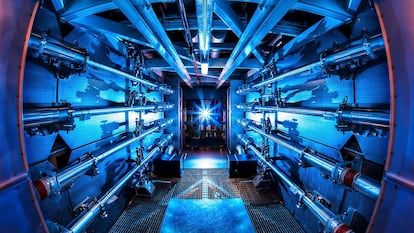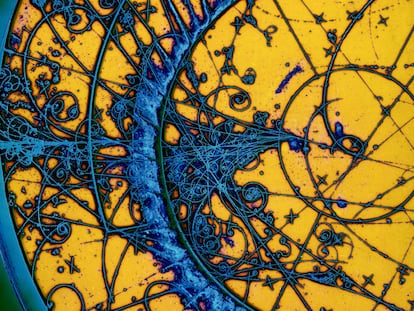Will the massive use of nuclear fusion alter the composition of the atmosphere?
Nuclear fusion produces reactions that are very different from the chemical processes we know from burning fuel

The great advantage of nuclear fusion is that a huge amount of energy can be produced from just a few grams of fuel. More specifically, one gram of fuel in the fusion process has the potential to generate the equivalent of eight tons of oil. In the same way, the Sun is able to supply energy to the entire planet Earth through fusion reactions.
Something similar happens with fission, the process that is currently used to produce energy in operating nuclear power plants. The amount of fuel (uranium in this case) needed is very little compared to the fuel required by thermal power plants that burn coal, gas, or oil. No matter how massive the use of fusion energy becomes in the future, its use (due to the extraction of necessary materials and the emission of gases) will never be so great as to alter the composition of our atmosphere. Furthermore, fusion is an energy production process that does not emit greenhouse gases.
The use of hydrogen isotopes will be necessary for fusion reactors to become widespread. Isotopes are atoms of the same element (with the same number of electrons and protons), but with a different number of neutrons. This feature means that the different isotopes of an element have the same chemical properties, but different physical properties. The fusion reactions that occur at the lowest temperature are those produced between deuterium and tritium. Deuterium is very abundant in seawater and can be extracted by hydrolysis. And tritium will be produced in the fusion reactor itself, since the neutrons from the fusion reactions impact a regenerating mantle composed of lithium, among other elements. A neutron and a lithium atom produce tritium as a byproduct that will be reused as fuel in the plasma. Plasma is the material that causes the nuclei to fuse and produce energy. It is an ionized gas with a temperature higher than 11,000 degrees Fahrenheit.
Nuclear reactions occur in fusion as well as fission, but are different from the processes we know from burning fuel: processes based on chemical reactions. In the case of fusion, we need to bring the nuclei closer together so that the nuclear forces come into play and attract each other strongly. When they fuse, they form a new element whose mass weighs less than the sum of the masses of the initial nuclei. This difference in mass (although it is almost insignificant) has the capacity to be transformed into energy by Einstein’s famous equation E=mc². It should be noted that the process involves very light elements. Fusion uses isotopes of hydrogen, which is the lightest element in nature. Hydrogen is the first element in the periodic table, because it has only one proton and one electron. And next is helium. By joining two hydrogens through a nuclear fusion reaction, we obtain helium and a surplus that is a neutron, and it is this neutron that has a lot of energy.
To get an idea of the amount of material needed as fuel, there is a density one million times less than the density of the air we breathe in the plasma confinement machines that are used for fusion experiments. This means that there are very few particles. The density is so low that no matter how many reactions occur with the release of helium, it will never be able to alter the composition of the atmosphere. Neither due to the consumption of hydrogen nor due to the emissions produced by fusion reactions, because these emissions will not contain CO₂.
Sign up for our weekly newsletter to get more English-language news coverage from EL PAÍS USA Edition
Tu suscripción se está usando en otro dispositivo
¿Quieres añadir otro usuario a tu suscripción?
Si continúas leyendo en este dispositivo, no se podrá leer en el otro.
FlechaTu suscripción se está usando en otro dispositivo y solo puedes acceder a EL PAÍS desde un dispositivo a la vez.
Si quieres compartir tu cuenta, cambia tu suscripción a la modalidad Premium, así podrás añadir otro usuario. Cada uno accederá con su propia cuenta de email, lo que os permitirá personalizar vuestra experiencia en EL PAÍS.
¿Tienes una suscripción de empresa? Accede aquí para contratar más cuentas.
En el caso de no saber quién está usando tu cuenta, te recomendamos cambiar tu contraseña aquí.
Si decides continuar compartiendo tu cuenta, este mensaje se mostrará en tu dispositivo y en el de la otra persona que está usando tu cuenta de forma indefinida, afectando a tu experiencia de lectura. Puedes consultar aquí los términos y condiciones de la suscripción digital.
More information
Últimas noticias
From Christmas movies to carols: Trump administration uses the holidays to push its anti-immigrant agenda
Trump’s worldview clashes with a Europe trying to defend itself
The program that guarantees Denver migrants will end up on the ‘Success Wall’
Venezuelan oil, the ultimate prize coveted by the United States
Most viewed
- Christian Louboutin: ‘Young people don’t want to be like their parents. And if their parents wear sneakers, they’re going to look for something else’
- ‘El Limones’ and the growing union disguise of Mexican organized crime
- The low-cost creative revolution: How technology is making art accessible to everyone
- ‘We are dying’: Cuba sinks into a health crisis amid medicine shortages and misdiagnosis
- Cartels in Mexico take a leap forward with narco-drones: ‘It is criminal groups that are leading the innovation race’










































